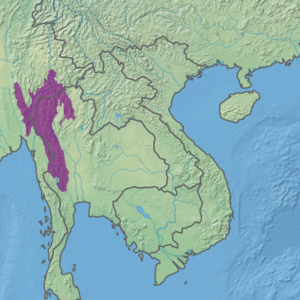Kayah-Karen montane rain forests
The Kayah-Karen montane rain forests is a tropical moist broadleaf forest ecoregion in Myanmar and Thailand. The montane rain forests cover several connected mountain ranges, including the Dawna Range, Karen Hills, Thanon Thong Chai Range, Daen Lao Range, and Khun Tan Range.
| Kayah-Karen montane rain forests | |
|---|---|
 Ecoregion territory (in purple) | |
| Ecology | |
| Realm | Indomalayan realm |
| Biome | tropical and subtropical moist broadleaf forests |
| Borders | List
|
| Geography | |
| Area | 119,158 km2 (46,007 sq mi) |
| Countries | Myanmar and Thailand |
| Administrative divisions of Myanmar, provinces of Thailand | |
| Conservation | |
| Conservation status | Relatively stable/intact |
| Protected | 32,354 km² (27%)[1] |
Geography
The Kayah-Karen montane rain forests occupy an area of 119,158 km². The mountain ranges lie in the border region between Myanmar and Thailand. The Dawna, Thanon Thong Chai, Daen Lao, and Khun Tan ranges separate the Salween River basin to the west from that of the Chao Phraya and Mekong rivers on the east. The Karen Hills extend to the northwest, separating the Salween and Sittaung River basins. The ecoregion includes the valley of the Salween River in Kayin, Kayah, and southern Shan states.
Climate
The climate is tropical, with warm humid and rainy summers and dry and mild winters. Average annual rainfall ranges from 1,500 to 2,000 mm. The climate is influenced by the Southwest monsoon coming from the Bay of Bengal, which brings more rain to the westward-facing mountain slopes.[2]
Flora
The ecoregion is at the transition between the tropical monsoon forests of central and southern Indochina and the subtropical forests of northern Indochina. Forest plant communities vary with elevation, latitude, rainfall, and soils.[3]
Fauna
The ecoregion has 168 species of mammals, including several threatened species. Larger mammals include tiger (Panthera tigris), Asian elephant (Elephas maximus), gaur (Bos gaurus), banteng (Bos javanicus), wild water buffalo (Bubalus arnee), Asian black bear (Ursus thibetanus), mainland serow (Capricornis milneedwardsii), clouded leopard (Pardofelis nebulosa), Malayan tapir (Tapirus indicus), dhole (Cuon alpinus), Assam macaque (Macaca assamensis), stump-tailed macaque (Macaca arctoides), smooth-coated otter (Lutrogale perspicillata), great Indian civet (Viverra zibetha), and particoloured flying squirrel (Hylopetes alboniger). The ecoregion has one endemic mammal, Kitti's hog-nosed bat (Craseonycteris thonglongyai).[4]
The ecoregion is home to 568 species of birds, including one endemic species, the Burmese yuhina (Yuhina humilis).
Protected areas
A 2017 assessment found that 32,354 km², or 27%, of the ecoregion is in protected areas.[5] Protected areas include Doi Luang National Park, Erawan National Park, Huai Kha Khaeng Wildlife Sanctuary, Khlong Wang Chao National Park, Khun Chae National Park, Mae Tuen Wildlife Sanctuary, Namtok Mae Surin National Park, Op Luang National Park, Salawin National Park, and Taksin Maharat National Park in Thailand.
External links
- "Kayah-Karen montane rain forests". Terrestrial Ecoregions. World Wildlife Fund.
References
- Eric Dinerstein, David Olson, et al. (2017). An Ecoregion-Based Approach to Protecting Half the Terrestrial Realm, BioScience, Volume 67, Issue 6, June 2017, Pages 534–545; Supplemental material 2 table S1b.
- Wikramanayake, Eric; Eric Dinerstein; Colby J. Loucks; et al. (2002). Terrestrial Ecoregions of the Indo-Pacific: a Conservation Assessment. Washington, DC: Island Press.
- Wikramanayake, Eric; Eric Dinerstein; Colby J. Loucks; et al. (2002). Terrestrial Ecoregions of the Indo-Pacific: a Conservation Assessment. Washington, DC: Island Press.
- Wikramanayake, Eric; Eric Dinerstein; Colby J. Loucks; et al. (2002). Terrestrial Ecoregions of the Indo-Pacific: a Conservation Assessment. Washington, DC: Island Press.
- Eric Dinerstein, David Olson, et al. (2017). An Ecoregion-Based Approach to Protecting Half the Terrestrial Realm, BioScience, Volume 67, Issue 6, June 2017, Pages 534–545; Supplemental material 2 table S1b.